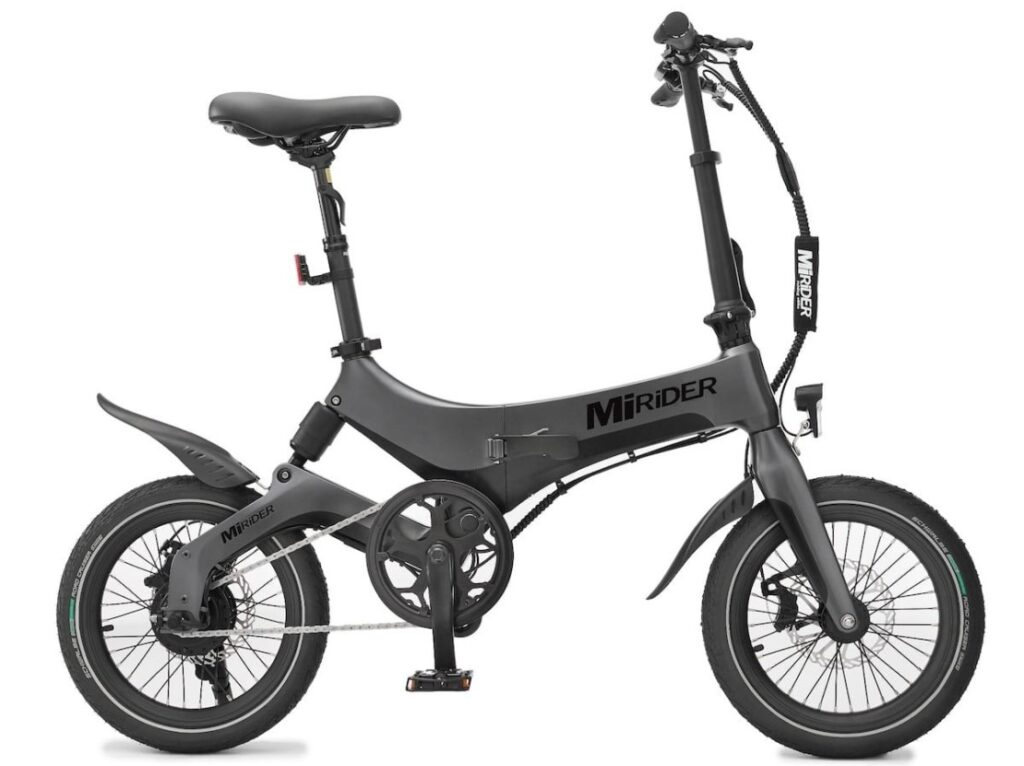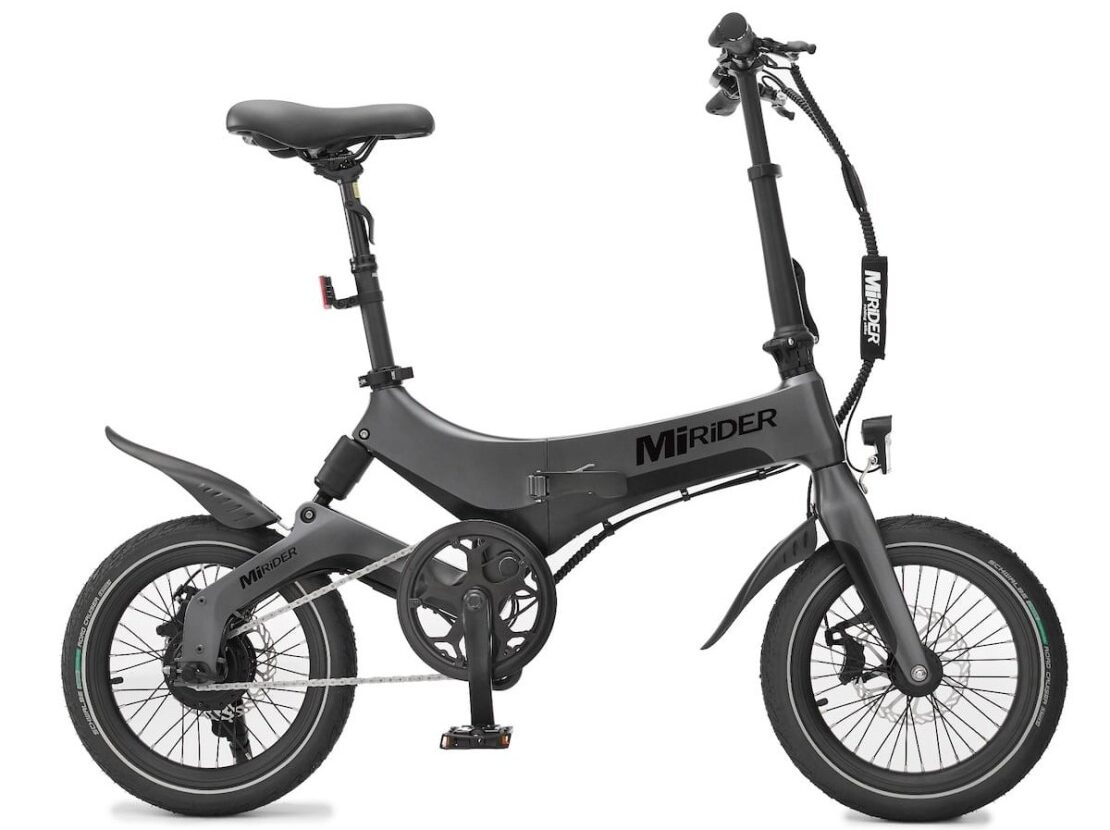
The MiRider One is a compact folding electric bike designed for urban commuters who need portability without sacrificing performance. Priced around £1,600, it targets those seeking a quick, hassle-free ride with real-world practicality. Unlike many folders, the One balances size, comfort, and power, featuring a powerful 250 W geared rear-hub motor delivering 40 Nm torque, ride-ready accessories, and a foldable magnesium alloy frame.
In this thorough test, we explored inner-city commutes, weekday errands, short leisure rides, and even hilly paths. We evaluated how it folds, how fast it accelerates, how it handles, and how far it can truly go. Our focus was on its compact design, user experience, practicality for mixed transport, and component quality. This review explores every aspect—from frame build to braking and range—to determine if the MiRider One delivers on its promise of small-size utility and everyday fun. And how it stacks up to the best foldable ebikes.
Specs at a Glance
- Motor: 250 W geared rear hub motor, 40 Nm torque
- Battery: 36 V / 252 Wh (Samsung cells), ~45 mile real range
- Weight: 17.3 kg (fully equipped)
- Top Speed: 25 km/h (15.5 mph)
- Frame Options: One‑size compact fold
- Tyres: 16″ × 2.125″ with Delta‑Guard puncture protection
- Brakes: Clark CMD‑24 hydraulic discs
- Suspension: Single rear spring damper
- Gearing: No derailleur; relies on assist and throttle
- Price: Approximately £1,600
Design and Build Quality
From the first glance, the MiRider One exudes quality. Its magnesium alloy frame is both lightweight and unexpectedly sturdy, handling rider weights up to 120 kg with confidence. The welds are neat, and the folding joints feel solid—no squeaky play even after repeated use. Coated with a resilient finish, the frame resists scuffs and keeps looking sharp through urban use.
Magnesium front hub and alloy forks offer durability with minimal bulk. The folding pedals and handlebars snap down quickly, and the locking magnets on the wheels ensure the bike stays together when carried. Hydraulic Clark CMD‑24 disc brakes are integrated into the legs of the frame, and their weather-sealed design speaks to intentional build quality.
The seatpost-mounted battery is lockable and easy to remove. Though compact, it has a secure fit, and key removal feels reassuring. Integrated mudguards, kickstand, and folding pedals enhance usability straight from the box. The display is basic but clear, set within a sturdy handlebar mount. Overall, the MiRider One’s build quality feels thoughtful and commuter-ready, showing attention to detail in both materials and manufacturing.
Motor Performance and Power Delivery
The geared rear-hub motor delivers 40 Nm of torque—impressive for a folder this small. Launching from a standstill, a brief press of the thumb throttle (which only works when pedalling) sends a firm surge of power that helped me dart ahead at lights with confidence. In assist levels 3–5, the motor remained whisper-quiet and responsive, pushing me to cruising speeds in seconds and maintaining pace against moderate headwinds.
Hill performance impressed. Tackling a 10–15 percent incline in a suburban setting, the One climbed steadily without overheating, showing no hesitation even when nudged toward 25 km/h. The ride remained smooth—there was no jerking or sudden power cut-off. While it lacks geared shifting, the direct motor power felt efficient and dependable.
In comparison to similarly priced hub-drive folders, the MiRider One stood out for its torque and solidity. Motor noise was sometimes audible at top speed, but never intrusive. Riders coming from non-electric bikes will appreciate its pulse and surge. What sets it apart is that it blends folding convenience with real motor output, making it feel less like a gimmick and more like a serious commuter choice.
Battery Range and Charging
Equipped with a 252 Wh Panasonic/Samsung battery, MiRider claims up to 72 km of range. Our real-world testing put it closer to 70 km in Eco mode and around 45–50 km using mid-to-high assist in mixed terrain. On a typical urban 20 km round trip, using assist levels 3–4, the battery dropped by roughly 30 percent, translating to a full day of commuting without recharging.
Charging takes 2 to 3 hours, using the supplied 42 V, 2 A charger. You can charge the battery on or off the frame, which is helpful in small flats. The lockable seatpost design secures the battery when riding and ensures it won’t rattle loose—though you’ll need the key to remove it. Battery management seems well-handled: even after extended use, voltage displayed on the LCD remained accurate, and LED indicators dropped predictably, avoiding sudden cut-offs in the ride.
The battery is rated for around 1,000 cycles—translating to multiple years for typical users. The compact charger is handy for desk or kitchen use, and range is consistent across seasons, though heavy use in winter cold shaved 10–15 percent off capacity.
Ride Quality and Comfort
The MiRider One rides surprisingly well for its size. Despite 16-inch wheels, the Delta-Guard tyres deliver a plush ride, absorbing potholes and rough pavement. The small-wheel geometry requires a slightly firmer steering hand, but initial twitchiness quickly gives way to confidence after a few blocks.
Comfort is boosted by the single rear spring-damper, which soaks minor bumps, especially over brickwork or tram lines. The saddle is supportive, neutral in shape, and the seat height adjusts easily. Upright geometry promotes visibility in traffic and reduces strain on back and shoulders.
Commute-mode riders will appreciate how easily the bike accelerates in urban settings. The quick throttle response and smooth assist make stop-start riding intuitive, less fatiguing than traditional folders. Taller riders (~195 cm) found it still manageable, helped by adjustable handlebars—though some exceeded leg extension comfort zone.
Heavier riders (~100 kg) reported stability remained strong, though they slightly exceeded ideal folded weight limits when lifting. Overall comfort felt consistent across rider sizes—whether lightweight or heavier, the One delivered reliable support and everyday usability.
Braking and Handling
Clarks CMD‑24 hydraulic disc brakes are a welcome surprise. They offered firm, predictable stopping power from any speed, remaining consistent in dry and wet conditions. Lever modulation was excellent: smooth initial bite, escalating to strong stopping force when needed. No fading occurred, even after repeated urban braking.
Handling is agile, with a small turning radius ideal for weaving through bike lanes. The trade-off is that sharp turns at speed require rider anticipation. Stability on descents felt planted, and the hydraulic brakes aided in controlled slowing. Though 16-inch wheels can skip on debris, the Delta Guard tyres maintained traction when cornering or braking hard.
Overall, control feels intuitive. Motor-brake cut-off ensures safe coordination, and brake placement on the small frame is well optimized. The rear damper adds security but has limited travel, meaning larger bumps can still unseat momentum but not rider confidence.
Features and Accessories
Out of the box, the MiRider One includes front and rear mudguards, folding pedals, kickstand, magic wheel magnets for folding, and extant LED front light and rear reflector. The comprehensive package means it’s commuter-ready without add-ons.
The thumb throttle provides instant boost, legal in the UK because it restricts to pedal-activated use. The LCD display is clean—backlit, shows speed, ride distance, trip, battery level (as percent), assist level, and headlight status. While there’s no smartphone connectivity, the simplicity is refreshing; controls are obvious and require minimal instruction.
Battery lock adds anti-theft security. The seatpost battery system also allows upgrading to a spare battery or optional rack-mounted battery in future versions. Optional accessories include a pannier rack and phone holder—though lack of a built-in rack means you’ll need to purchase. But for a folder this small, that’s not unreasonable. The carry bag accessory works well for storage or international travel.
Weight and Portability
Weighing 17.3 kg fully equipped, the MiRider One is light for an e-folder and manageable to carry or lift. Folding to 770×430×680 mm, it fits under desks, into train lockers, and inside small car boots.
Folding takes under 10 seconds: collapse the frame, fold pedals, drop handlebars, lock with magnets—done. Rolling folded is possible but awkward on uneven surfaces. The bike balances well when lifted by the seat or frame joint. Despite compact size, it’s stable to handle in public transport—no dangling parts, and latch points feel rugged.
It’s built for multi-modal travel: lighter than many 20” electric folders yet sturdy. For those carrying up stairs or on buses, it’s friendly. For weekend storage or apartment life, it occupies minimal space—few bikes compete on convenience.
Value for Money
At ~£1,600, the MiRider One offers strong value: a UK-assembled, feature-rich folding e-bike with quality components. Many competitors over £2,000 either skimp on durability, braking, or range.
The mid-powered motor holds its own in city hills; hydraulic brakes enhance safety; the magnesium frame is premium. Warranty and direct UK support make ownership less uncertain than overseas brands. Build quality is good—this isn’t a cheap import.
Alternatives like ADO Air 20 or Brompton Electric come at a higher price, heavier weight, or more limited range. MiRider punches above its compact size. For commuters needing a quick-to-fold, ride-ready bike, it offers better performance at similar cost.
It suits city dwellers, students, multi-modal workers, and small-flat dwellers. If you need long-distance touring or heavy cargo, a larger bike may be better—but for daily city use, the One is hard to beat in its class.
Pros & Cons
Pros:
- Compact, sturdy, UK-built folding e-bike
- Strong 40 Nm motor with instant throttle boost
- Clear hydraulic braking and smooth rear suspension
- Locking, removable battery, commuter-ready accessories
Cons:
- No axle rack by default
- Small display lacks Bluetooth/app features
- 16” wheels feel twitchy to some riders
Verdict
The MiRider One delivers a rare blend of compactness, power, and build quality—all at a competitive price. It’s designed for riders who need folding agility without compromising on ride capability: comfortable enough for daily commutes, effective on city hills, and compact enough to ride-park-ride. The tone is confident—this bike isn’t a novelty, it’s a well-conceived urban tool. If you’re seeking a no-fuss, quick-folding, ride-ready commuter with real performance in a space-saving package, the MiRider One is a compelling and practical choice. And one of the best electric bikes for the price range.


